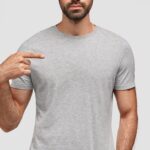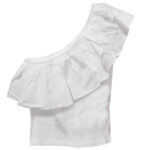I. Introduction
In the ever-evolving landscape of the North American fashion industry, staying ahead of trends is paramount for retailers and wholesalers alike. The dynamics of consumer preferences and the constant flux of fashion fads directly impact the success of businesses. In this blog, we delve into the current fashion trends in the North American region, shedding light on how understanding and adapting to these trends can significantly impact sales.
A. Unraveling North American Fashion Trends
To successfully navigate the fashion industry, it’s crucial to decipher the intricacies of North American fashion trends. The market is ever-changing, influenced by factors ranging from celebrity styles to socio-cultural movements. Whether it’s embracing sustainable fashion, streetwear aesthetics, or minimalist designs, understanding the pulse of the consumer base is key.
B. The Impact of Fashion Trends on Retail
Fashion trends aren’t just about aesthetics; they have a profound impact on retail strategies. Retailers who align their offerings with prevailing trends are more likely to capture consumer attention and, subsequently, increase sales. This section explores how being attuned to these trends can be a strategic advantage in the competitive retail landscape.
C. Exploring the Influence of Trendy Pairings on Market Demand
Beyond individual clothing items, the art of pairing different pieces to create a cohesive and trendy look is a significant factor in driving market demand. We will discuss the influence of curated fashion ensembles on consumer preferences and how retailers can leverage this to boost their sales.
In the subsequent sections, we will delve into practical strategies for maximizing sales, minimizing costs in wholesale operations, and elevating profits for boutique stores. Stay tuned for insights into the 15 most cost-effective clothing wholesale distributors in 2024, as we navigate the intersection of fashion, business, and profitability.
II. Fashion Trends and Sales
The fast-paced world of fashion requires retailers and wholesalers to not only keep up with trends but to strategically integrate them into their business models. In this section, we will unravel the relationship between fashion trends and sales, exploring how staying in tune with what’s “in” can significantly impact the bottom line.
A. Decoding North American Fashion Trends
Understanding North American fashion trends is akin to deciphering a constantly evolving code. From the dominance of athleisure to the resurgence of vintage aesthetics, the market dynamics are shaped by a myriad of influences. Retailers need to be astute observers, recognizing shifts in consumer preferences and adapting their offerings accordingly.
B. Seizing the Momentum: Adapting to Fashion Trends for Increased Sales
In the competitive realm of retail, staying ahead of the curve is not just a strategic advantage—it’s a necessity. We will explore how businesses can proactively integrate current trends into their product offerings, creating a connection with consumers seeking the latest styles. This adaptability not only attracts new customers but also fosters loyalty among existing ones.
C. The Power of Curated Fashion: Impact on Market Demand
Beyond individual fashion items, the magic often lies in how they are curated and presented. The art of pairing different pieces to create a visually appealing and trendy ensemble is a potent force in driving market demand. We’ll delve into the psychology of consumer choices, examining how well-curated fashion combinations can significantly influence purchasing decisions.
By navigating the intricate relationship between fashion trends and sales strategies, businesses can position themselves as trendsetters and cater to the ever-evolving desires of the consumer market. The subsequent sections will further explore tactics for enhancing sales through effective product pairing and delve into the intricacies of cost-effective clothing wholesale. Stay tuned for practical insights that can transform your business in 2024.

III. Elevating Sales through Styling Techniques
In the fashion industry, the way products are styled and presented plays a pivotal role in influencing consumer choices. In this section, we will explore the art of pairing and presentation, shedding light on techniques that can elevate sales by creating an irresistible allure for customers.
A. Crafting Visual Stories: The Power of Product Pairing
The impact of visual storytelling through product pairing cannot be overstated. Retailers can enhance the appeal of their offerings by showcasing how different pieces complement each other. We will delve into case studies showcasing successful product pairings, demonstrating how this technique not only boosts sales for individual items but also encourages customers to explore complementary pieces.
B. Trendy Combinations that Sell: Practical Examples
Understanding the synergy between various fashion items is crucial. We’ll provide practical examples of trendy combinations that have proven to be successful in the market. Whether it’s mixing and matching patterns, textures, or styles, these combinations create a curated aesthetic that resonates with the contemporary consumer.
C. The Psychology of Presentation: Influencing Purchase Decisions
Beyond the products themselves, the way they are presented can profoundly influence consumer perceptions. We’ll discuss the psychological aspects of presentation, exploring how factors like color schemes, product placement, and visual aesthetics contribute to a positive shopping experience. By understanding these nuances, retailers can create an atmosphere that encourages customers to make confident and satisfying purchase decisions.
By mastering the art of styling and presentation, retailers can differentiate themselves in a crowded market, captivate their audience, and ultimately boost sales. The following sections will delve into strategies for cost-effective clothing wholesale, emphasizing how these techniques can be applied on a larger scale to maximize impact. Stay tuned for insights on optimizing your wholesale operations for increased profitability in 2024.
IV. Cost-Saving Strategies in Clothing Wholesale
Efficient management of costs is a cornerstone for success in the competitive realm of clothing wholesale. In this section, we will explore strategies to minimize expenses, ensuring that wholesale operations remain not only financially viable but also optimized for sustainable growth.
A. Bulk Purchases: Driving Cost Efficiency
One of the fundamental ways to reduce costs in clothing wholesale is through bulk purchasing. By ordering large quantities of inventory, wholesalers can negotiate better prices with suppliers, take advantage of discounts, and benefit from economies of scale. We will delve into the intricacies of bulk purchasing, highlighting its impact on overall cost reduction and improved profit margins.
B. Streamlining Transportation and Warehousing Costs
The logistics of moving and storing inventory can significantly contribute to operational expenses. This section will examine strategies for streamlining transportation and warehousing costs. From optimizing shipping routes to implementing efficient storage solutions, wholesalers can adopt practices that minimize overheads and contribute to a leaner operation.
C. Effective Inventory Management: Minimizing Holding Costs
Carrying excess inventory ties up capital and incurs holding costs. We will explore the importance of effective inventory management in minimizing these expenses. Implementing just-in-time inventory systems, utilizing forecasting tools, and regularly reassessing stock levels are among the strategies that wholesalers can employ to strike a balance between meeting demand and avoiding unnecessary holding costs.
In the upcoming sections, we will focus on profit growth strategies for boutique stores, including the advantages of dropshipping and customization. These approaches not only contribute to increased revenue but also align with the evolving preferences of modern consumers. Stay tuned for insights on optimizing your boutique’s profitability in the dynamic landscape of 2024.

V. Profit Growth Strategies for Boutique Stores
Boutique stores occupy a unique space in the retail landscape, and their profitability is often intertwined with innovative strategies and personalized customer experiences. In this section, we will delve into strategies that boutique owners can adopt to not only increase revenue but also enhance their brand’s appeal.
A. The Power of Individualization: One-Item Dropshipping and Customization
- One-Item Dropshipping: Boutique stores can explore the benefits of one-item dropshipping, a model where products are sourced and fulfilled on a per-order basis. This not only minimizes inventory holding costs but allows for a curated selection that aligns precisely with customer demand.
- Customization for Personalized Experiences: Offering customized products allows boutiques to cater to the growing consumer desire for personalized experiences. Whether it’s monogramming, bespoke designs, or tailored fits, providing customization options adds a unique touch that can command premium prices and foster customer loyalty.
B. Increasing Revenue Streams: Beyond Traditional Sales
- Diversification with Accessories and Complementary Products: Boutique stores can explore avenues for diversification by incorporating accessories and complementary products. This not only expands the product range but also encourages customers to purchase multiple items, thereby increasing the average transaction value.
- Limited Editions and Exclusivity: Creating a sense of exclusivity through limited edition releases can stimulate demand and attract a dedicated customer base. By leveraging scarcity and uniqueness, boutiques can command higher prices and enhance their brand image.
C. Niche Focus: Targeting Specialized Audiences
- Catering to Niche Markets: Identifying and catering to niche markets can be a lucrative strategy for boutique stores. Whether it’s sustainable fashion, gender-neutral clothing, or other specialized segments, focusing on a niche allows boutiques to build a community of dedicated customers who share specific interests.
- Collaborations and Partnerships: Collaborating with influencers, local artists, or other brands can create synergies that elevate a boutique’s appeal. Such partnerships not only bring fresh perspectives to the product line but also widen the reach of the boutique’s brand.
By adopting these profit growth strategies, boutique stores can navigate the dynamic retail landscape and carve out a distinct identity. The subsequent sections will delve into optimizing wholesale operations for cost-effectiveness and highlight the most cost-effective clothing wholesale distributors in 2024. Stay tuned for actionable insights to propel your boutique’s success in the evolving market.
VI. Profit Optimization in Wholesale Operations
Efficient management of wholesale operations is essential for maximizing profits in the highly competitive fashion industry. In this section, we will explore strategies that wholesalers can employ to optimize their operations, enhance profit margins, and navigate the challenges of the wholesale business.
A. Elevating Profit Margins: Strategic Approaches
- Value-Added Services: Wholesalers can differentiate themselves by offering value-added services, such as personalized packaging, branding support, or efficient order fulfillment. These services not only enhance customer satisfaction but can justify premium pricing, contributing to higher profit margins.
- Private Labeling: Creating a private label allows wholesalers to establish a unique brand identity and command higher prices. By offering exclusive products under their own label, wholesalers can reduce price competition and build stronger relationships with retailers.
B. Strategic Sourcing and Inventory Management
- Strategic Sourcing: Identifying reliable and cost-effective suppliers is fundamental to profit optimization. Wholesalers should strategically source products, considering factors like quality, lead times, and production costs. Negotiating favorable terms with suppliers can contribute to overall cost reduction.
- Dynamic Inventory Management: Implementing dynamic inventory management practices, including real-time tracking and demand forecasting, enables wholesalers to minimize excess inventory and associated holding costs. This ensures that stock levels align closely with market demand, optimizing cash flow and reducing financial strain.
C. Leveraging Technology for Efficiency
- Automation and Order Processing: Integrating automation into order processing and inventory management streamlines operations, reduces errors, and minimizes labor costs. Wholesalers can leverage technology to automate routine tasks, allowing their teams to focus on more strategic aspects of the business.
- Data Analytics for Informed Decision-Making: Utilizing data analytics provides valuable insights into customer preferences, market trends, and operational efficiency. Wholesalers can make informed decisions based on data-driven intelligence, optimizing product assortments and pricing strategies.
In the subsequent sections, we will delve into strategies for cost-effective clothing wholesale, including the advantages of bulk purchasing and effective transportation and warehousing practices. Stay tuned for actionable insights on navigating the wholesale landscape and maximizing profitability in 2024.

VI. Profit Optimization in Wholesale Operations
In the intricate realm of wholesale operations, strategic decisions play a pivotal role in shaping profit margins. In this section, we will delve into comprehensive strategies that wholesalers can adopt to optimize their operations, boost profit margins, and thrive in a competitive market.
A. Elevating Profit Margins: Strategic Value Addition
- Value-Added Services: Wholesalers can distinguish themselves by offering value-added services that go beyond the mere transaction. Personalized packaging, branding support, or efficient order fulfillment not only enhance customer satisfaction but also position the wholesaler as a strategic partner. This added value can justify premium pricing, contributing to higher profit margins.
- Private Labeling: The creation of a private label allows wholesalers to establish a unique brand identity. By offering exclusive products under their own label, wholesalers not only reduce reliance on external branding but also gain the ability to command higher prices. Private labeling can be a strategic move towards building brand recognition and customer loyalty.
B. Strategic Sourcing and Inventory Management
- Strategic Sourcing: Wholesalers must meticulously evaluate suppliers based on factors such as quality, lead times, and production costs. Negotiating favorable terms with reliable suppliers can significantly contribute to overall cost reduction. A strategic approach to sourcing ensures that the quality of products aligns with market demand.
- Dynamic Inventory Management: The key to profit optimization lies in dynamic inventory management. Real-time tracking, demand forecasting, and agile inventory practices allow wholesalers to minimize excess stock and holding costs. By synchronizing stock levels with market demand, wholesalers can optimize cash flow and reduce financial strain.
C. Leveraging Technology for Operational Efficiency
- Automation and Order Processing: The integration of automation into order processing and inventory management enhances operational efficiency. Automation streamlines routine tasks, reduces errors, and minimizes labor costs. Wholesalers can leverage technology to automate repetitive processes, allowing their teams to focus on more strategic aspects of the business.
- Data Analytics for Informed Decision-Making: Data analytics provides wholesalers with actionable insights into customer preferences, market trends, and operational efficiency. Informed decision-making based on data-driven intelligence allows wholesalers to optimize product assortments, pricing strategies, and overall business operations.
VII. 15 Most Cost-Effective Wholesale Distributors in 2024
As we navigate the landscape of wholesale fashion, identifying reliable and cost-effective distributors is crucial for the success of retailers and boutique owners. In 2024, the following 15 wholesale distributors stand out for their commitment to affordability without compromising quality.
- KakaClo: Known for a diverse range of trendy clothing at competitive prices, KakaClo is a go-to choice for retailers seeking affordable fashion.KakaClo Website

- CatwalkWholesale: A distributor with a reputation for staying on top of the latest trends, CatwalkWholesale offers a variety of stylish options for businesses on a budget.CatwalkWholesale Website
- Dear-Lover: Dear-Lover is recognized for its extensive catalog, featuring everything from casual wear to evening dresses, all at budget-friendly prices.
- FashionTIY: With a commitment to transparency and low prices, FashionTIY connects retailers with manufacturers directly, cutting out unnecessary costs.
- Faire: Faire’s platform brings together a curated selection of emerging and established brands, providing retailers with access to unique products at competitive prices.

- Trendsi: Trendsi specializes in on-trend, affordable fashion, making it an ideal choice for boutiques looking to refresh their inventory regularly.
- BrandsGateway: Offering a mix of well-known brands and emerging designers, BrandsGateway provides retailers with access to high-quality products at competitive wholesale prices.
- FashionGo: A comprehensive marketplace, FashionGo connects retailers with a wide range of suppliers, enabling them to source affordable and stylish products.
- LASHOWROOM: LASHOWROOM is a wholesale fashion platform catering to boutique owners, offering a curated selection of trendy and cost-effective items.LASHOWROOM Website
- LAShowroom: LAShowroom is known for its extensive range of fashion items, providing retailers with access to a variety of products at competitive prices.
- Stylepick: Stylepick is a fashion wholesale platform that connects retailers with manufacturers, offering a wide range of products at affordable rates.Stylepick Website
- Showpo: Showpo stands out for its trendy and affordable fashion selections, making it a favorite among retailers looking for on-point styles.Showpo Website

- DHgate: DHgate is an online marketplace that connects buyers with suppliers directly, offering a vast range of products at competitive prices.
- CC Wholesale Clothing: CC Wholesale Clothing is known for its budget-friendly wholesale prices, particularly for those looking for trendy styles in bulk.CC Wholesale Clothing Website
- Banggood: Banggood provides a diverse range of products, including fashion items, at competitive prices, making it a popular choice for cost-effective wholesale purchases.Banggood Website
These 15 wholesale distributors offer a mix of affordability, variety, and quality, catering to the diverse needs of retailers in 2024. Remember to explore each platform to find the one that aligns best with your business requirements and preferences.
VIII. Conclusion
In the dynamic world of fashion retail and wholesale, adapting to trends, optimizing operations, and strategically selecting suppliers are paramount for success. As we conclude this exploration into the intricacies of the industry, let’s recap the key takeaways that can empower businesses in 2024.
- Navigating Fashion Trends:
- Understanding and adapting to North American fashion trends is essential for staying relevant in the market.
- The art of curated fashion ensembles significantly influences consumer preferences and purchasing decisions.
- Styling for Success:
- Crafting visual stories through product pairings enhances the appeal of offerings.
- Practical examples of trendy combinations showcase successful styling techniques.
- Wholesale Cost Savings:
- Bulk purchasing, strategic sourcing, and dynamic inventory management are fundamental to reducing costs.
- Streamlining transportation, warehousing, and leveraging technology contribute to efficient wholesale operations.
- Boutique Profit Growth:
- One-item dropshipping, customization, and diversification with accessories contribute to boutique revenue growth.
- Niche focus, collaborations, and limited editions enhance the unique appeal of boutique stores.
- Wholesale Profit Optimization:
- Value-added services and private labeling elevate profit margins for wholesalers.
- Strategic sourcing, dynamic inventory management, and leveraging technology contribute to efficient wholesale operations.
- Cost-Effective Wholesale Distributors:
- The 15 selected wholesale distributors, including KakaClo, CatwalkWholesale, and Dear-Lover, offer a diverse range of cost-effective and trendy products.
- Platforms like Faire, FashionTIY, and BrandsGateway provide retailers with unique and affordable options.
In a landscape where trends evolve rapidly, and consumer preferences shift dynamically, businesses that proactively adapt and optimize their strategies are better positioned for success. Whether you’re a boutique owner seeking profit growth or a wholesaler aiming for efficiency, the strategies and distributors highlighted here provide a roadmap for navigating the challenges and opportunities of the fashion industry in 2024. Stay agile, stay innovative, and thrive in the ever-evolving world of fashion.







